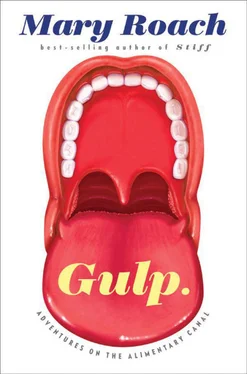After everyone else leaves, Langstaff shares some of the group’s answers (with names removed). Those who performed well on the oil rankings—incredibly, several got it close to exact—also noted that aroma number 7, on the first test, was not just olive oil, but rancid olive oil. Four out of twenty people, all olive professionals, nailed that detail. (The oil smelled fine to me. I was right there with the numb-nose who wrote, on his answer form, “Oh, for a piece of good bread!”)
Here’s what I find interesting. The people who work with olives and olive oil, most of whom performed supernaturally well on the ranking and triangle tests, were occasionally stumped by some of the most common and, to me, obvious aromas. A woman who, in the initial sniff test, realized that the olive oil was “rancid, fusty” failed to recognize almond extract. She wrote, “Cranberry, fruity, sweet, aloe juice.” She described diacetyl, the smell of artificial (movie popcorn) butter, as “licorice, candy, bubble gum.” Those aren’t important flavors in the day-to-day of the olive world, so there’s no reason for her to know them. This supports what Langstaff said earlier. As with any language, proficiency builds with exposure and practice. (Though not quickly; the average training period for a sensory panelist is sixty hours.)
In my case, it won’t be happening any time soon. An e-mail from Langstaff arrives around nine that night. “Hi Mary. Hope you enjoyed the tryouts. Unfortunately you did not make the cut.”
SENSORY ANALYSIS IS not limited to the epicurean industries of Napa Valley. For any food or drink manufactured on a reasonably large scale, there are trained panelists and sensory descriptors. Poking around in the sensory-science journals, I have seen flavor lexicons for mutton, strawberry yogurt, chicken nuggets, ripening anchovies, almonds, beef, chocolate ice cream, pond-raised catfish, aged Cheddar cheese, rice, apples, rye bread, and “warmed-over flavor.”
The work entails more than just troubleshooting. Sensory analysts and panels help with product development. They keep the flavors of established products on track when a formula is altered—say, to lower the fat or salt content. They work with the market research staff. When focus groups of consumers prefer one version of, say, a ranch dressing over another (or over a competitor’s dressing), sensory evaluators may be brought in to figure out the salient attributes of the more popular item. The food scientists can then work backward from those attributes to tweak the formula.
Why use humans rather than lab equipment? Because the latter would yield dozens of chemical differences [9] Probably more. The Handbook of Fruit and Vegetable Flavors includes a four-page table of aroma compounds identified in fresh pineapple: 716 chemicals in all.
between a pair of products. Without a human evaluator, it’s impossible to assign sensory meaning to them. Which of those dozens of differences in chemical makeup translates to a perceptible flavor shift, and which is below the threshold for human detection? Which ones, in short, make the difference in the consumer’s mouth and mind? “And you can’t ask the consumer,” says Langstaff. “You ask the consumer, ‘Why does it taste better?’ They say, ‘Because I like it better.’” The consumer’s flavor lexicon is tiny: yum and yuck.
Which product the sensory evaluator prefers, by the way, is irrelevant. He or she may not like any of them, or even the general category. (Langstaff, for instance, rarely drinks beer for pleasure.) “You don’t ask your gas chromatograph if it likes the olive oil it’s analyzing,” Langstaff told us at the tryouts. The goal is to be as neutral, as analytical—as “Mr. Spock”—as possible.
This perhaps explains how it was possible for a team of Canadian researchers to find nine men and women willing to create a canned-cat-food flavor lexicon and a set of tasting protocols. For humans. Tasting cat food. And they couldn’t be shy about it. The protocol for evaluating the “meat chunk” portion (“gravy gel” having its own distinct protocol) stipulated that the sample be “moved around mouth and chewed for 10 to 15 seconds, [and] a portion of the sample swallowed.”
The idea was to come up with a sort of code, a way to translate the mute preferences of cats. In theory, companies could use human tasters and sensory profiles of the foods cats like in order to predict the success of new formulations. In practice, the technique never really took off.
Because there was a concern that people with a “strong negative attitude” toward tasting cat food would drop out before the project ended, panel applicants at the initial screening were asked not only to describe the cat foods but also to rate them according to how much they liked them. (The average rating, I am gobsmacked to report, fell between “like mildly” and “neither like nor dislike.”) Thanks to this unusual data set, we now know that humans prefer cat food with a tuna or herbal flavor over cat food with the flavor descriptors “rancid,” “offaly,” “cereal,” or “burnt.”
But humans, as we are about to see, are not cats.
2. I’ll Have the Putrescine
YOUR PET IS NOT LIKE YOU


DESPITE THE CRYPTIC name and anonymous office-park architecture, the nature of the enterprise that goes on at AFB International is clear the moment you sit down for a meeting. The conference room smells like kibble. One wall of it, entirely glass, looks onto a small-scale kibble extrusion plant where men and women in lab coats and blue sanitary shoe covers tootle here and there pushing metal carts. AFB makes flavor coatings for dry pet foods. To test the coatings, they first need to make small batches of plain kibble and add the coatings. The flavored kibbles are then presented to consumer panels for feedback. The panelists—Spanky, Thomas, Skipper, Porkchop, Rover, Elvis, Sandi, Bela, Yankee, Fergie, Murphy, Limburger, and some three hundred other dogs and cats—reside at AFB’s Palatability Assessment Resource Center (PARC), about an hour’s drive from the company’s suburban St. Louis headquarters.
AFB Vice President Pat Moeller, myself, and a few other staff members are seated around an oval conference table. Moeller is middle-aged, likable, and plain-spoken. He has a small mouth with naturally deep red lips and a pronounced Cupid’s bow, but it would be inaccurate to say he has a feminine appearance. Moeller once consulted for NASA, and he has that look. The fundamental challenge of the pet-food professional, Moeller is saying, is to balance the wants and needs of pets with those of their owners. The two are often at odds.
Dry, cereal-based pet foods caught on during World War II, when tin-rationing put a stop to canning, including the canning of dog food made from horse meat (of which there was an abundance around the time Americans embraced the automobile and began selling their mounts to the knackers). Regardless of what pets made of the change, owners were delighted. Dry pet food was less messy and stinky, and more convenient. As a satisfied Spratt’s Patent Cat Food customer of yesteryear put it, the little biscuits were “both handy and cleanly.”
To meet pets’ nutrition requirements while also giving humans the cheap, handy, cleanly product they demand, mainstream pet-food manufacturers blend animal fats and meals with soy and wheat grains and add vitamins and minerals. This yields a cheap, nutritious pellet that no one wants to eat. Cats and dogs are not grain-eaters by choice, Moeller is saying. “So our task is to find ways to entice them to eat enough for it to be nutritionally sufficient.”
Читать дальше














